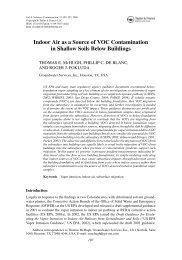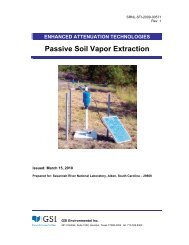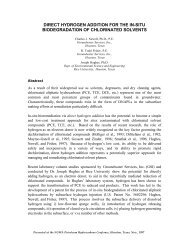Calculation and Use of First-Order Rate Constants for Monitored ...
Calculation and Use of First-Order Rate Constants for Monitored ...
Calculation and Use of First-Order Rate Constants for Monitored ...
Create successful ePaper yourself
Turn your PDF publications into a flip-book with our unique Google optimized e-Paper software.
Effect <strong>of</strong> Sorption on Concentration vs.Time Pr<strong>of</strong>ilesChanges in Concentration vs.Time pr<strong>of</strong>iles as a result <strong>of</strong> sorption were evaluated by plotting the pr<strong>of</strong>iles at the source <strong>and</strong> downgradientlocations <strong>for</strong> different retardation factors. For this analysis a longitudinal dispersivity <strong>of</strong> 100 ft was assumed. As can be seen in thefigures below, the time required to reach steady-state increases as the retardation factor increases. Sorption, however, does notchange the steady-state concentration. (Note the two graphs have different scales.)Concentration (mg/L)10987654321R=1R=2R=5R=10Near source location00 20 40 60 80 100 120Time (yr)5R=14R=2R=5Concentration (mg/L)32R=10Downgradient location100 20 40 60 80 100 120 140Time (yr)22






